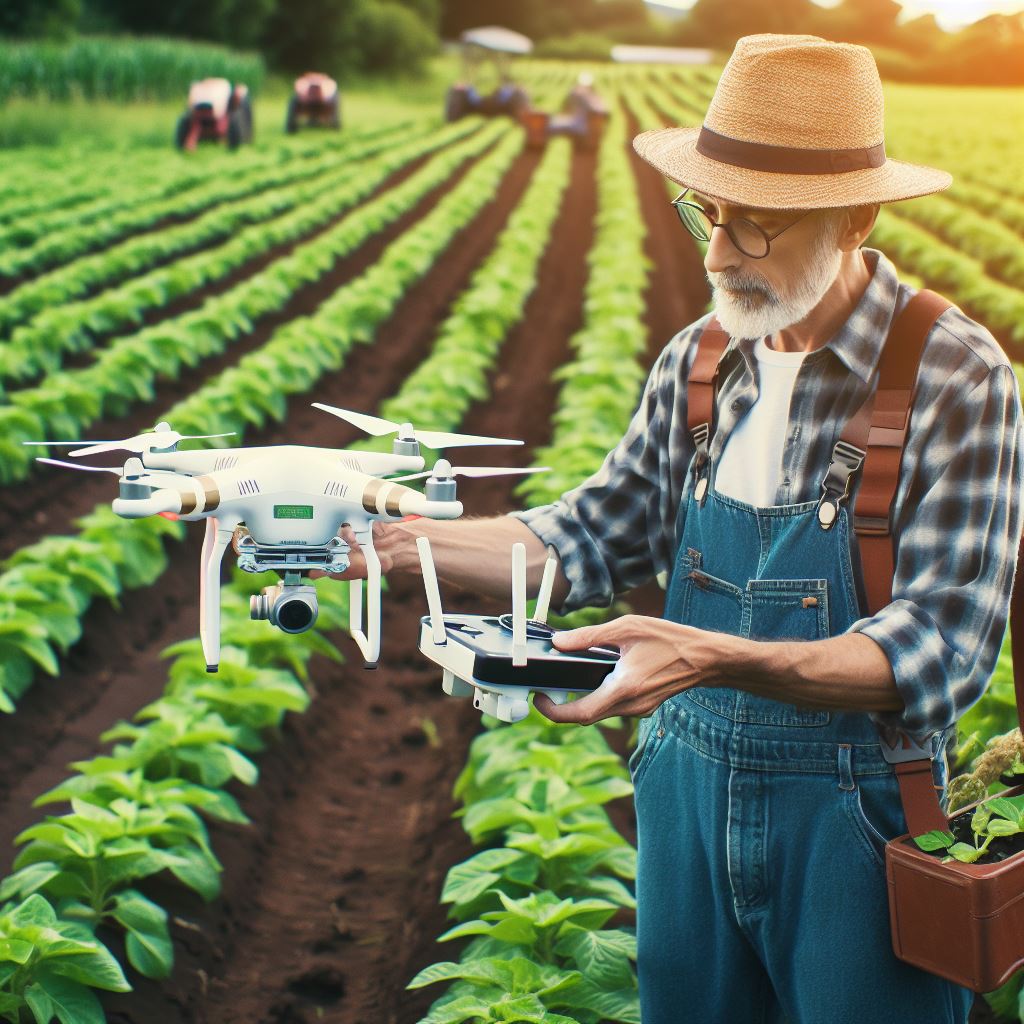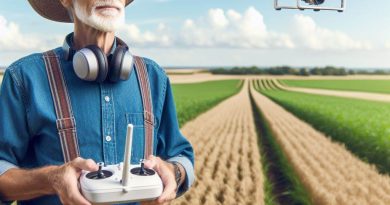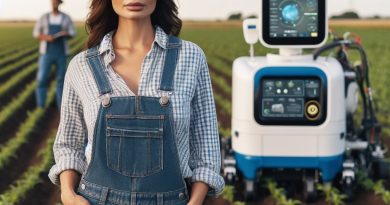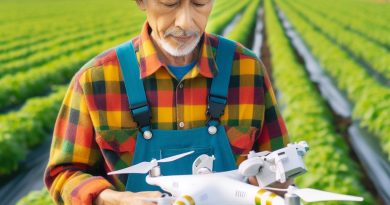Future of Farming: Drone Technology
Last Updated on January 18, 2024
Introduction
Farming has always been a vital industry, but its future potential is even more promising.
With the constant advancements in technology, farming practices are evolving to meet the increasing demands of a growing population.
One notable innovation in this field is drone technology.
Brief Overview of the Future Potential of Farming
The future of farming holds immense opportunities to enhance productivity, sustainability, and efficiency.
As the global population continues to rise, the need for increased food production becomes crucial.
Traditional farming methods alone may soon become insufficient to meet these demands.
Transition to the Focus on Drone Technology
In recent years, drone technology has gained significant popularity in the agricultural sector.
Drones equipped with sophisticated cameras and sensors offer valuable insights into crop health, field conditions, and yield estimations.
The ability to monitor vast areas of farmland quickly and accurately has revolutionized the way farmers manage their fields.
By using drones, farmers can collect and analyze data in real-time, allowing for proactive decision-making based on accurate information.
This technology enables farmers to identify crop stress, pests, or diseases at an early stage and take prompt action to mitigate potential losses.
In addition, drones can provide precise data regarding irrigation requirements, optimizing water usage and reducing the environmental impact of farming practices.
Furthermore, drones equipped with precision spraying systems have made significant advancements in targeted pesticide application.
This targeted approach reduces the overall amount of chemicals used and minimizes potential harm to the environment, while still effectively protecting crops.
Basically, drone technology presents a promising future for the farming industry.
The integration of drones into agricultural practices allows for increased accuracy, efficiency, and sustainability, ultimately benefiting both farmers and consumers.
As this technology continues to evolve, its potential to revolutionize farming practices remains limitless.
Definition of drone technology
Drone technology is revolutionizing the future of farming by providing innovative and efficient solutions.
Drones, also known as unmanned aerial vehicles (UAVs), are remotely operated aircraft that can be used for various applications.
In recent years, they have gained popularity in the agriculture industry due to their ability to collect valuable data and perform tasks that were once time-consuming and labor-intensive.
Key applications of drone in farming
So, how exactly are drones used in farming? Let’s explore some of the key applications:
- Crop Monitoring: Drones equipped with cameras and sensors can capture high-resolution images of crops. This data helps farmers identify potential issues like pests, diseases, or nutrient deficiencies.
- Precision Agriculture: By analyzing the collected data, drones enable farmers to make data-driven decisions. They can precisely target specific areas of the farm that require treatment, reducing the need for indiscriminate application of fertilizers or pesticides.
- Irrigation Management: UAVs fitted with thermal imaging cameras can detect temperature differences in crops, indicating variations in water distribution. This information aids farmers in optimizing irrigation schedules and conserving water resources.
- Crop Spraying: Drones equipped with sprayers can efficiently apply pesticides, fertilizers, or even beneficial insects to crops. This method is not only more precise but also reduces human exposure to potentially harmful chemicals.
- Livestock Monitoring: Drones can easily cover large areas and provide real-time surveillance of livestock. This allows farmers to monitor their animals for signs of distress, identify injured or missing animals, and prevent potential threats from predators.
Additional Applications of drones in farming
- Yield Estimation: By using advanced imaging techniques, drones can accurately assess crop health and estimate yields. This information is valuable for forecasting harvests and optimizing logistics, ensuring proper storage and transportation of agricultural produce.
- Mapping and Surveying: Drones equipped with GPS technology and specialized software can create detailed maps of farms, including topography and field boundaries. This data assists in land management, resource planning, and complying with environmental regulations.
- Wildlife Conservation: Drones have proven to be effective tools for wildlife monitoring and protection. They enable researchers to gather data on animal populations, track migration patterns, and identify potential habitats for conservation efforts.
- Weather Monitoring: Drones can be equipped with weather sensors to collect real-time meteorological data, such as temperature, humidity, and wind speed. This information helps farmers make informed decisions regarding planting, harvesting, and overall farm management.
- Emergency Response: In the event of natural disasters or emergencies, drones can be deployed for search and rescue operations and damage assessment. They provide quick access to remote areas, saving time and potentially saving lives.
As technology continues to advance, drones are becoming more accessible and affordable for farmers of all sizes.
However, it is important to note that the use of drones in agriculture must comply with local regulations and privacy laws.
In short, drone technology is revolutionizing farming practices and enhancing productivity.
From crop monitoring and precision agriculture to livestock monitoring and emergency response, drones offer a wide range of applications that improve efficiency, sustainability, and profitability in the agricultural sector.
As the future unfolds, it is clear that drones will continue to play a vital role in shaping the future of farming.
Read: Hydroponics 101: Basics & Benefits
Benefits of using drones in agriculture
Farming has come a long way over the centuries, and advancements in technology have played a significant role in transforming the industry.
One such technological innovation that has revolutionized agriculture is drone technology.
With their ability to perform various tasks with precision and efficiency, drones have become invaluable tools for farmers worldwide.
In this section, we will explore the numerous benefits of using drones in agriculture.
Increased efficiency and productivity
- Drones offer farmers the ability to cover large areas of land in a short amount of time.
- They can monitor crop health and detect areas that require immediate attention.
- Using advanced imaging sensors, drones can provide detailed information on crop growth, moisture levels, and nutrient deficiencies.
- This real-time data allows farmers to make informed decisions about fertilization, irrigation, and pest control.
- By identifying and addressing issues promptly, drones help farmers maximize crop yields and overall productivity.
Reduction in labor and costs
- Traditionally, farmers have relied on manual labor for tasks such as crop monitoring and inspection.
- These labor-intensive activities can be time-consuming, costly, and often prone to errors.
- With drones, farmers can automate these tasks, reducing the need for manual labor.
- Drones can cover large areas quickly, collecting data and providing insights that would have otherwise required a significant workforce.
- This reduction in labor not only saves costs but also allows farmers to allocate resources more efficiently.
Precision farming techniques
- Drones equipped with specialized sensors and imaging technologies enable precision farming techniques.
- They can accurately apply fertilizers, pesticides, and herbicides to specific areas in a targeted manner.
- This targeted application minimizes wastage, reduces the impact on the environment, and ensures efficient use of resources.
- Drones can also create detailed maps of fields, helping farmers identify variations in soil composition and moisture levels.
- By precisely applying resources according to these variations, farmers can optimize crop growth and minimize input wastage.
Generally, utilizing drone technology in agriculture offers a myriad of benefits that significantly improve efficiency, productivity, and sustainability.
Drones provide farmers with valuable data and insights, allowing them to make informed decisions and adapt their farming practices accordingly.
By automating labor-intensive tasks, drones reduce costs and enhance the allocation of resources.
Moreover, precision farming techniques facilitated by drones result in the optimal use of fertilizers, pesticides, and herbicides, minimizing environmental impact.
As technology continues to advance, the future of farming is undoubtedly intertwined with the continued evolution of drone technology.
Read: Top 5 Trends in Vertical Farming Tech
Types of Drone Applications in Farming
Drones have revolutionized the agricultural industry by providing farmers with efficient and precise solutions for various tasks.
These unmanned aerial vehicles have proven to be valuable tools, improving crop management and overall farm productivity.
In this section, we will explore different types of drone applications in farming and their benefits.
Crop Monitoring and Assessment
Drones equipped with high-resolution cameras and sensors enable farmers to monitor their crops more effectively.
These aerial robots can capture detailed images and collect data about plant health, growth patterns, and potential issues.
The collected information assists farmers in identifying areas that require attention, such as nutrient deficiencies, pests, or diseases.
With timely intervention, farmers can take appropriate measures to prevent yield loss and optimize crop productivity.
Crop Spraying and Seed Planting
Traditional methods of crop spraying and seed planting can be time-consuming and labor-intensive.
However, drones equipped with spray systems and seed dispensers can accomplish these tasks quickly and efficiently.
By precisely targeting specific areas, drones can apply fertilizers, pesticides, and herbicides with increased accuracy.
This targeted approach minimizes the use of chemicals, reducing environmental impact and optimizing resource utilization.
Livestock Monitoring and Management
Managing livestock is crucial for ensuring their health and well-being, as well as maintaining farm profitability.
Drones equipped with thermal cameras and sensors can monitor livestock over vast areas, providing real-time data on their movements, behavior, and health conditions.
This information helps farmers detect potential issues early on, such as injuries, illness, or escape attempts, allowing for timely intervention and preventing losses.
Irrigation Management
Proper irrigation is vital for crop growth and productivity.
Drones equipped with infrared sensors can analyze plant water stress levels and provide valuable insights into irrigation needs.
By precisely determining areas with inadequate or excessive moisture levels, farmers can optimize their irrigation strategies.
This not only conserves water resources but also prevents waterlogged or dry soil conditions, leading to improved crop health and yield.
By utilizing drones for these various applications, farmers can benefit from increased efficiency, reduced costs, and improved decision-making.
These unmanned aerial vehicles allow farmers to gather accurate data, analyze it, and make informed decisions regarding crop management.
With drones, farmers can react promptly to any potential problems, thereby minimizing crop losses and maximizing yields.
Essentially, drone technology has revolutionized the future of farming.
The diverse applications of drones, including crop monitoring and assessment, crop spraying and seed planting, livestock monitoring and management, and irrigation management, enhance farm productivity and sustainability.
By harnessing the power of drones, farmers can embrace precision agriculture and stay ahead in the ever-changing agricultural landscape.
Read: Soil Health Monitoring: New Tech Trends

Case studies and examples of drone technology in action
In the future of farming, drone technology is revolutionizing the way farmers operate.
With the ability to cover vast areas quickly and efficiently, drones have become an essential tool in modern agriculture.
In this section, we will explore case studies, success stories, and the results of using drones in specific scenarios.
Case Studies and Examples of Drone Technology in Action
One notable case study is the use of drones in crop monitoring.
With advanced imaging sensors, drones can analyze crop health and identify areas that require attention.
Farmers can then take proactive measures to address issues such as nutrient deficiencies or pest infestations.
This targeted approach saves time and resources while maximizing crop yield.
Another example is the use of drones for precision spraying.
Traditional spraying methods often result in uneven distribution of chemicals, leading to wasted resources and potential harm to the environment.
Drones equipped with GPS and precision spraying mechanisms can apply fertilizers and pesticides with pinpoint accuracy, reducing waste and minimizing the impact on surrounding ecosystems.
Success Stories from Farmers Using Drones
Farmers worldwide have experienced significant success with drone technology in their operations.
For instance, John, a soybean farmer in Iowa, implemented drone-based aerial mapping to create detailed field maps.
By analyzing the data collected, John identified areas of poor drainage and adjusted his irrigation systems accordingly.
As a result, he observed a 10% increase in crop yield and saved thousands of dollars in water costs.
In Australia, Sarah, a cattle farmer, adopted drones for livestock monitoring.
With thermal imaging cameras, she can quickly detect sick or injured animals, allowing for timely intervention.
This proactive approach has reduced mortality rates and improved overall animal welfare on her farm.
Results and Impacts of Using Drones in Specific Scenarios
The use of drones in pest control has also yielded significant results.
Instead of indiscriminate spraying of pesticides, drones can accurately target affected areas, reducing the overall use of chemicals and minimizing harm to beneficial insects and organisms.
This approach promotes sustainable farming practices while effectively managing pest populations.
In vineyards, drones equipped with multispectral cameras have transformed the way farmers assess crop health.
By analyzing the images captured, farmers can detect signs of disease or stress early on, allowing for prompt treatment.
This proactive approach has led to higher-quality grapes and improved wine production.
Furthermore, the use of drones for soil analysis has revolutionized the way farmers manage their land.
By collecting data on soil composition and nutrient levels, farmers can create precise fertilization plans tailored to the needs of specific areas, optimizing crop growth and minimizing fertilizer runoff.
In general, drone technology has emerged as a game-changer in the future of farming.
Case studies and success stories from farmers around the world demonstrate the tangible benefits of using drones in various agricultural scenarios.
From crop monitoring to precision spraying, drones offer efficiency, accuracy, and sustainability that traditional farming practices struggle to match.
As technology continues to evolve, we can expect even greater advancements in drone technology and its impact on agriculture.
Read: Sustainable Farming via Tech Innovations
Challenges and limitations of drone technology in agriculture
With the introduction of drone technology in agriculture, there are numerous challenges and limitations that farmers must consider.
These include regulations, costs, and data management challenges.
Regulations and legal considerations
One of the primary challenges of using drone technology in agriculture is the strict regulations and legal considerations surrounding their use.
In many countries, drones are subject to restrictions such as flight altitude, distance from airports, and even licensing requirements.
Failure to comply with these regulations can result in fines and legal consequences for farmers.
Initial investment and maintenance costs
Another significant challenge is the initial investment and maintenance costs associated with drone technology.
Drones themselves can be expensive, and farmers must also invest in additional equipment such as cameras and sensors to collect useful data.
Moreover, regular maintenance and repair costs can quickly add up, making it a significant financial commitment for farmers.
Data management and processing challenges
Data management and processing also present challenges for farmers utilizing drone technology.
Drones can collect vast amounts of data, including images, videos, and sensor readings.
However, managing and processing this data requires specialized software and expertise, which may not be readily available to all farmers.
Without effective data management and processing systems, the potential benefits of drone technology may go untapped.
Limitations of drone technology
Furthermore, the limitations of drone technology itself pose challenges in agricultural applications.
Drones have a limited flight time and payload capacity, which restricts the area that can be covered in a single flight and the types of payloads that can be carried.
Additionally, adverse weather conditions such as strong winds or rain can significantly impact the performance and effectiveness of drones in agricultural operations.
Despite these challenges and limitations, the potential benefits of drone technology in agriculture are undeniable.
Drones can provide farmers with valuable insights into crop health, pest infestations, and irrigation needs.
This information can help optimize yield, reduce chemical usage, and improve overall farm management.
Overcoming these challenges
To overcome the challenges and make the most of drone technology, farmers can take certain steps.
Firstly, staying up to date with the regulations and obtaining the necessary licenses and permits is crucial.
Farmers must also carefully assess the costs involved, considering both the initial investment and ongoing maintenance expenses.
Collaborating with experts and outsourcing data management and processing tasks can help overcome the technical challenges associated with drone data.
Additionally, farmers need to be aware of the limitations of drone technology and set realistic expectations.
Integrating drones into existing farm management practices rather than relying solely on their capabilities is key to success.
Combining traditional methods with drone technology can enhance efficiency and productivity on the farm.
In essence, while there are challenges and limitations in using drone technology in agriculture, the potential benefits make it a tool worth exploring.
By addressing regulations, managing costs, and overcoming technical challenges, farmers can harness the power of drones to improve their farming practices and drive towards a more efficient and sustainable future.
Future trends and developments in drone technology
The future of farming is rapidly advancing, thanks to the innovative use of drone technology.
Drones are no longer just a hobbyist’s toy, but are now becoming essential tools for modern agriculture.
In this section, we will explore the future trends and developments in drone technology that will revolutionize farming.
Automated drone systems
Automated drone systems are gaining popularity in the agricultural industry.
These systems can be programmed to perform tasks such as crop monitoring, planting, and spraying.
They eliminate the need for manual labor and reduce the risk of human error.
This automation allows farmers to optimize their operations and increase productivity.
Integration with AI and machine learning
The integration of drones with AI and machine learning is another exciting development.
Drones equipped with AI can analyze data collected during flights and provide valuable insights to farmers.
They can identify crop health issues, pest infestations, and nutrient deficiencies, allowing farmers to take timely action.
Machine learning algorithms enable drones to improve their performance and accuracy over time, making them even more efficient.
Improved battery life and flight range
Improved battery life and flight range are crucial for the widespread use of drones in farming.
Longer battery life means drones can cover larger areas without needing frequent recharging.
This allows farmers to survey their fields more efficiently and gather comprehensive data.
Additionally, increased flight range enables drones to reach remote or inaccessible areas, ensuring complete coverage of the farm.
Benefits that drone technology brings to farming
Along with these trends, there are several benefits that drone technology brings to farming.
Firstly, drones enable farmers to monitor their crops in real-time, providing instant feedback on crop health and potential issues.
This allows for timely interventions, leading to better yields and reduced crop losses.
Secondly, drones can significantly reduce the use of pesticides and fertilizers.
By identifying specific areas that require treatment, farmers can apply chemicals more precisely, minimizing environmental impact. This also results in cost savings for farmers.
Furthermore, the use of drones in farming reduces the risk associated with manual labor.
Traditional agricultural tasks such as inspecting crops or dispersing chemicals can be dangerous, especially when dealing with large fields or challenging terrains.
Drones eliminate this risk by performing these tasks autonomously, keeping farmers safe.
Additionally, drones can cover vast areas in a short time, saving farmers time and effort.
Challenges that need to be addressed
Despite the numerous advantages, there are challenges that need to be addressed for the widespread adoption of drone technology in farming.
One challenge is the regulatory framework surrounding the use of drones.
Regulations vary across countries, and navigating through these rules can be cumbersome for farmers.
Governments need to establish clear guidelines that ensure the safe and responsible use of drones in agriculture.
Additionally, there is a need for standardized protocols for data collection and analysis, making it easier for farmers to interpret and act upon the information collected by drones.
In a nutshell, the future of farming lies in the hands of drone technology.
With automated systems, integration with AI and machine learning, improved battery life, and flight range, drones are set to revolutionize agriculture.
They offer numerous benefits such as real-time monitoring, precise chemical applications, risk reduction, and time savings.
However, there are challenges that need to be addressed, including regulations and standardized protocols.
Nonetheless, the potential of drones in farming is immense, and we can expect to see more advancements in the coming years.
Conclusion
Drone technology holds immense benefits and potential for the future of farming.
With the ability to monitor crops, spray pesticides, and collect data, drones can improve efficiency and productivity.
They can also help reduce the environmental impact of farming by targeting areas that need intervention rather than blanket spraying.
Furthermore, drones can assist in precision agriculture by identifying areas with nutrient deficiencies or pest infestations.
The data collected by drones can be analyzed to make informed decisions and optimize resources.
In the future, drones are expected to play an even larger role in agriculture, with advancements in technology and regulations.
It is envisioned that drones will work alongside farmers, aiding them in tasks such as planting, harvesting, and monitoring.
This collaboration between humans and drones has the potential to revolutionize agriculture, providing sustainable and efficient solutions.
However, challenges such as privacy concerns, safety regulations, and the cost of implementation need to be addressed.
Overall, the future impact of drones in agriculture is promising, with the potential to reshape the industry and improve farming practices.


